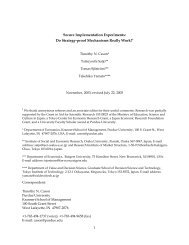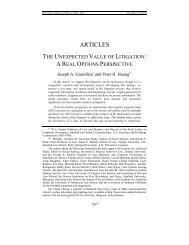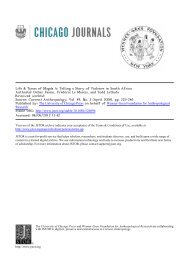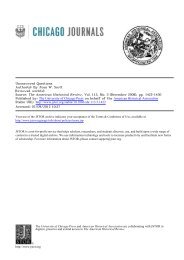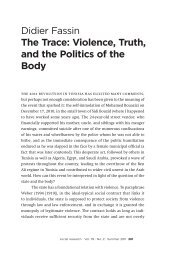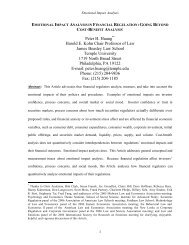Compassion and Repression: The Moral Economy of Immigration ...
Compassion and Repression: The Moral Economy of Immigration ...
Compassion and Repression: The Moral Economy of Immigration ...
You also want an ePaper? Increase the reach of your titles
YUMPU automatically turns print PDFs into web optimized ePapers that Google loves.
IMMIGRATION POLICIES IN FRANCE 379<br />
1939, <strong>and</strong> collected some half a million people in the south <strong>of</strong> France, the majority<br />
<strong>of</strong> whom were repatriated more or less voluntarily within a few months. During<br />
the weeks that followed the declaration <strong>of</strong> war against Germany, on September 3,<br />
1939, 83 “confinement camps for the enemies” were progressively added to the<br />
eight camps already devoted to Spanish refugees. <strong>The</strong> French policies at that time<br />
were much more repressive than those <strong>of</strong> other countries such as Great Britain.<br />
After the defeat in June 1940 <strong>and</strong> the instauration <strong>of</strong> the Vichy regime, the camps<br />
served first to detain communists <strong>and</strong> then, increasingly, Jews, but it was not until<br />
the spring <strong>of</strong> 1942 that they became the antechamber <strong>of</strong> the final solution under the<br />
designation <strong>of</strong> “transit camps.” When the war ended, the same camps ironically<br />
served to confine Nazi collaborators until May 1946.<br />
One should certainly not confuse Sangatte, conceived at first to give shelter<br />
to c<strong>and</strong>idates for immigration into Britain, with the transit camp <strong>of</strong> Drancy, the<br />
camp for “undesirable aliens which opened at Rieucros,” the camp for Spanish<br />
refugees <strong>of</strong> Saint-Cyprien, the camp at Chateaubri<strong>and</strong> where communist detainees<br />
were arbitrarily executed, <strong>and</strong> the camp at Montreuil-Bellay where 1,000 nomad<br />
Gypsies were held, or the Conciergerie where collaborationists were imprisoned<br />
after the liberation <strong>of</strong> Paris. Each one <strong>of</strong> them had its own reason for being, its<br />
specific logic <strong>of</strong> confinement, <strong>and</strong> its particular rules <strong>of</strong> control. However diverse<br />
the social realities <strong>of</strong> the camps may be in these different moments <strong>of</strong> the dark<br />
side <strong>of</strong> French history, the permanence <strong>of</strong> the camp structure is in itself revealing.<br />
Indeed, Erving G<strong>of</strong>fman (1961) discovered a common functioning <strong>of</strong> what he<br />
called “total institutions” behind the different motivations that gave birth to the<br />
psychiatric hospital, the prison, <strong>and</strong> the convent, <strong>and</strong> it may be possible to transcend<br />
the historical variety <strong>of</strong> the camps to unveil their shared signification.<br />
<strong>The</strong> camps correspond to a specific response to problems <strong>of</strong> public order<br />
by instituting small territories <strong>of</strong> exception. What justifies these local states <strong>of</strong><br />
exception is an emergency that makes the gathering up <strong>of</strong> people appear as a<br />
practical solution. But the suspension <strong>of</strong> the usual social norms is accepted only<br />
because it is implemented for “undesirable” subjects. A situation that should be<br />
considered intolerable is in fact tolerated because the public order is threatened by<br />
immigrants, enemies, communists, gypsies, Jews, <strong>and</strong> collaborators. <strong>The</strong>refore,<br />
because Sangatte is open for asylum seekers to come <strong>and</strong> go (under control <strong>of</strong> the<br />
police) <strong>and</strong> is administered by a humanitarian organization (with the collaboration<br />
<strong>of</strong> many volunteers), it cannot therefore be simply equated to other camps in<br />
modern French history. Nonetheless, the memory it disturbs tells us a pr<strong>of</strong>ound<br />
truth. This memory says less about the center than about its inmates—who might<br />
be better described as “vagabonds,” in Zygmunt Bauman’s (1998) terms. From a<br />
long-term perspective, it becomes obvious that the opening <strong>of</strong> Sangatte recasts the<br />
asylum seekers as the new “unwanted”—a role they have long occupied, as Michael<br />
Marrus recalls (1985). <strong>The</strong> present reinvention <strong>of</strong> the camp reveals the continuity<br />
<strong>of</strong> the preoccupation: the camp draws attention to those who are constructed as<br />
living outside the polis—literally, the “alienated.” <strong>The</strong> contemporary figure <strong>of</strong> the



